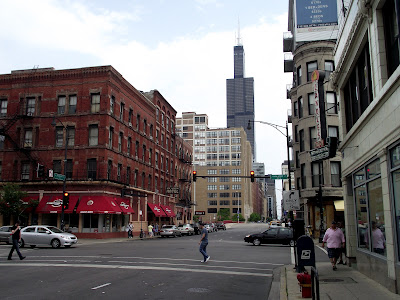The Breakdown
 |
| Welcome to Little Athens! |
An overview: Greektown, a neighborhood within a larger neighborhood (West Loop),
within an even larger neighborhood (Near West Side). Although not large
in terms of geography, Greektown does loom large as a classic, authentic ethnic
neighborhood sitting just outside downtown. Running down Halsted are no
fewer than a dozen Grecian restaurants (where you’re just as likely to hear
Greek as English), a couple taverns, a few small shops and grocers, and the
strip’s new anchor, the recently opened National Hellenic Museum.
Sitting a few blocks south of the Randolph Street
foodie’s wet dream, and less than a mile northeast of recently reinvigorated
and gentrified Little Italy, Greektown sometimes gets lost in the culinary mix.
But it’s definitely a worthwhile investment of time for a light al fresco
lunch with a chilled glass of white wine, or a late dinner in a neighborhood
that’s rocking up to 4 A.M.
 |
| Temple of Van Buren at Halstedopoulos. |
The boundaries: Tiny little Greektown rests entirely within a two by five block area.
Madison Street lies to the north, Green Street to the west, I-290
(Eisenhower Expressway) to the south, and I-90/94 (Kennedy Expressway) to the
east. Running right down the middle is Halsted Street, which is host to
the vast majority of the neighborhood’s dining and nightlife.
Population make-up: Greektown is far too small to have its own Census tract. As of
2010, it shares one going all the way west to Ashland. The make-up of
this particular tract is 64% white, 16% black, 10% Asian, and 7% Hispanic.
There are numerous lofts around the neighborhood that have been converted
from warehouses in the past 10 to 15 years, ensuring an always lively, vibrant
community.
A brief history: Greeks began to come over to Chicago in the 1840s, and by the early 1900s had established a neighborhood of their own
just south of present-day Greektown. This area, known as The Delta, was the
largest concentration of Greeks in the United States for much of the twentieth
century, with nearly 30,000 calling the area home. The development of the
interstate highway system in the 1950s (I-290 specifically in this instance),
as well as the development of the University of Illinois at Chicago, led to an exodus of most of
the area’s Greek population.
 |
| Halsted & Jackson. The heart of Greektown. |
Despite this, the Grecian influence never left.
Today, the Halsted strip between Madison and the Eisenhower thrives as a
classic ethnic neighborhood, alive at all hours of the day, especially on
weekend evenings. Though not large in terms of geography, Chicago’s
Greektown stands as one of the best (if not the best) authentic
Greektowns in the entire country.
Getting there: By L, it’s as easy as taking the Blue Line
to UIC-Halsted. Make sure you take the ramp up to Halsted and take a
left. It’ll take you right into the southern entryway to Greektown.
You can also get there on the bus. Going
north-south, just take the Halsted bus (8). Going east-west, there’s the
Madison bus (20) too.









